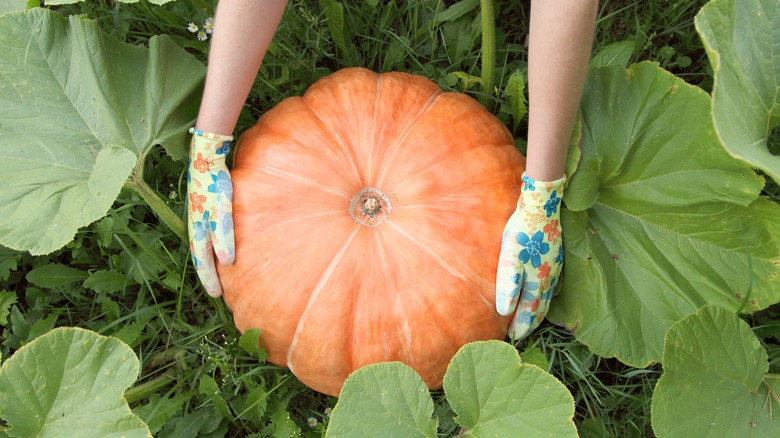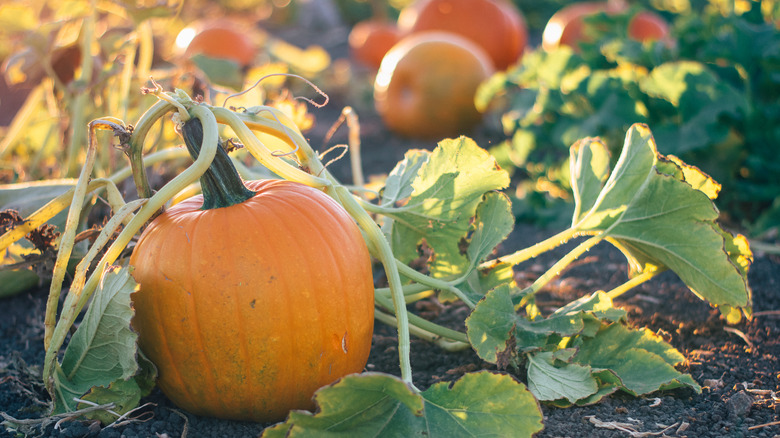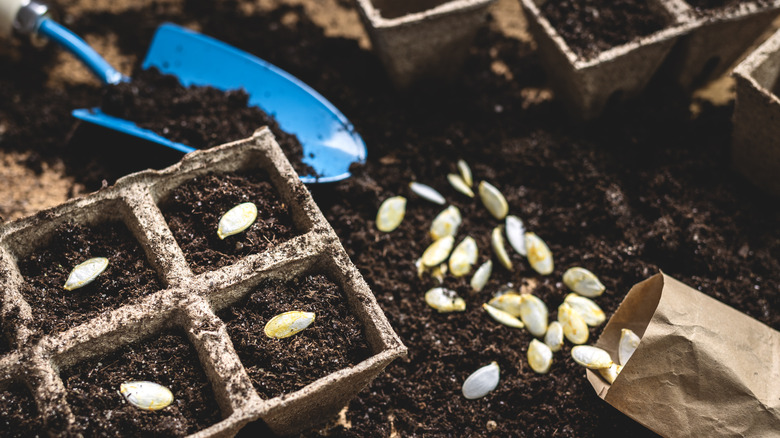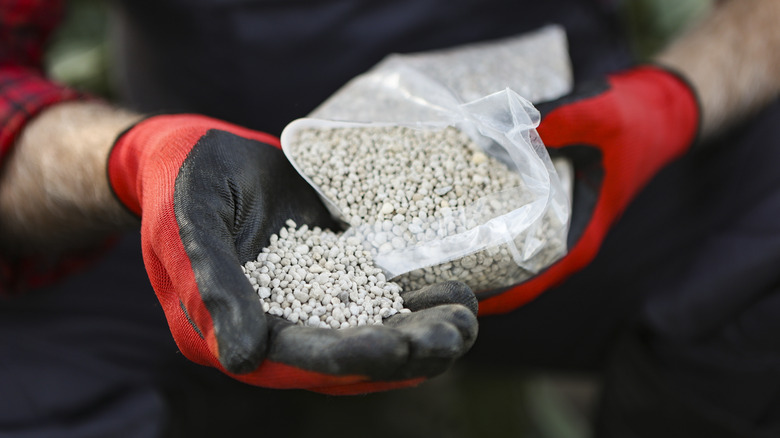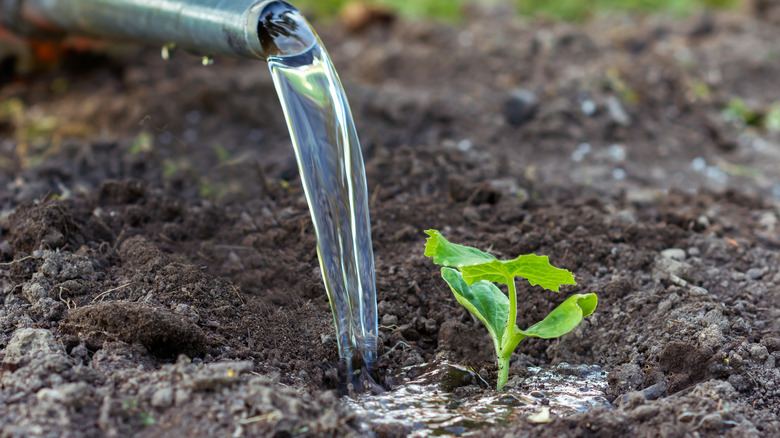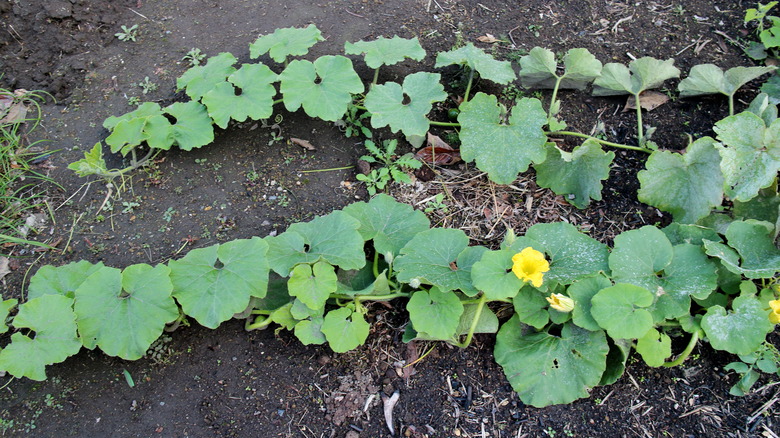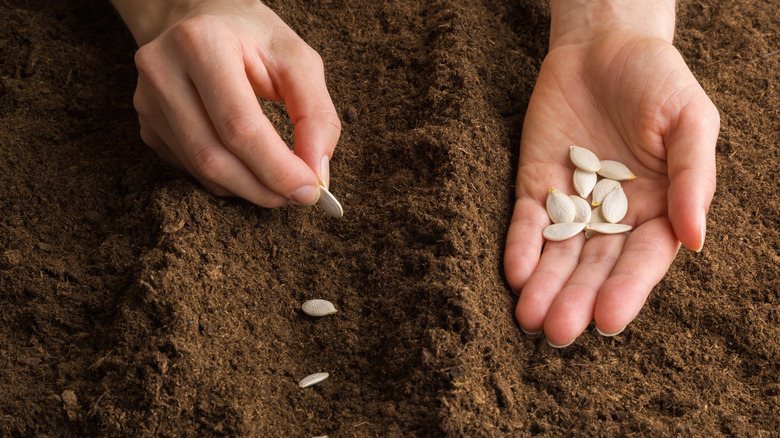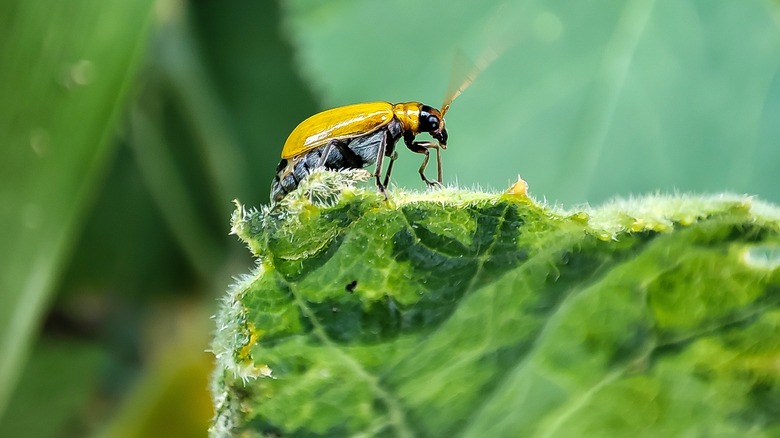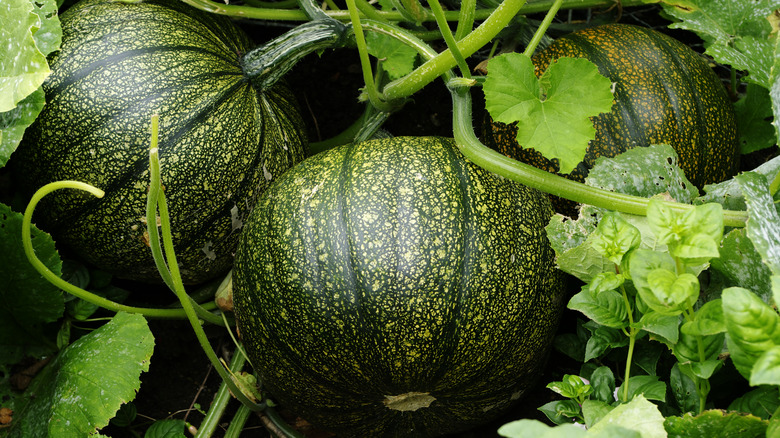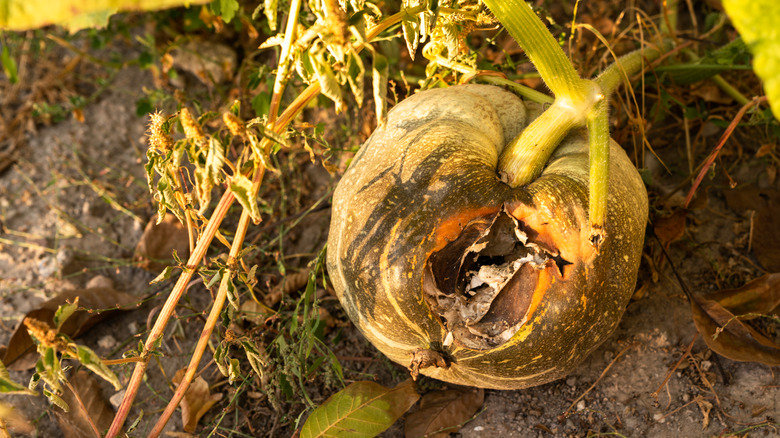Avoidable Mistakes Everyone Makes When Growing Pumpkins
If we had to choose an official fruit for autumn, the pumpkin would win by a landslide. While you can certainly pick one up at a grocery store or local pumpkin patch, there's something so rewarding about cultivating a few vines in your own garden. Maybe you want to grow your own to make pumpkin pies, butter, and other tasty treats, or you want them solely for carving and decoration. But there are some mistakes you should be aware of before you sow the first seed.
As you excitedly begin to plan your pumpkin patch, know that there are hundreds of varieties available, and they come in a wonderful array of colors, sizes, shapes, and textures. They require ample space, lots of water, and regular nourishment. However, they are still pretty easy to maintain. Even if your green thumb is still a work in progress, don't let that stop you! Read on to discover how to avoid common errors many people make when planting pumpkins.
Too much sunlight
Pumpkins are sun-loving plants, and therefore need to be planted in a full sun location. This means six to eight hours of uninterrupted sunlight each day. However, as is the case with too much of a good thing, the intensity of the sunlight can actually cause problems for your vine. Pumpkins can be scorched by the blazing, unforgiving heat of the afternoon sun. You'll first notice burns on the leaves and vines, but as the weeks go on without a respite, your pumpkins will start to rot on the vine.
To avoid this mistake, choose your garden's location and layout carefully. This is especially important if your growing zone is in an area prone to droughts because hot temperatures plus no rain will not equal vibrant pumpkins. Look for a space in your garden that provides full sun for most of the day, with some afternoon shade as the day winds down. Strong sunshine in the morning is critical because it will dry out the dew that accrued overnight.
Choosing the wrong seeds
When it comes to pumpkins, there's something for everyone. Smooth or bumpy? Round and fat or long and lean? Miniature or gargantuan? From classic orange to greenish-gray and salmon pink to bright white, there are tons of varieties available throughout the world. It's easy to get carried away with finding the most unique squash to fit your fall aesthetic, but you want to avoid choosing the wrong seeds. Otherwise, you could end up with disappointing sizes, unhealthy vines, or overcrowding.
The first step to avoiding this mistake is careful planning and thoughtful preparation. Familiarize yourself with your growing zone and only choose seeds that can thrive in your unique geographical area. Next, determine how much sunlight your pumpkin patch will receive. While many varieties thrive in sunshine, some, like the Long Island Cheese Pumpkin, actually flourish in heavy shade. If you're tempted to choose seeds from a humongous variety, like Dill's Atlantic Giant, make sure you've got space to spare (and then some). They need eight feet between each hill, and vines can reach 12 feet in length.
Failing to fertilize properly
Pumpkin vines work hard to produce all of their heavy fruit. After all, a medium pumpkin can weigh anywhere from ten to twenty pounds! So it comes as no surprise that pumpkins are commonly described as heavy feeders that need a steady supply of fertilizer. From organic options like beneficial compost and manure to commercial options containing nitrogen, phosphorus, and potassium, fertilizer comes in many forms. It's important to choose the one best suited for pumpkins as failing to nourish them properly can lead to weak vines, lackluster growth, small fruit, and overall poor output.
While you can certainly apply a standard, all-purpose vegetable garden fertilizer and call it a day, it's best to try a more personalized approach to maximize your pumpkins' potential. Different stages of growth require different nutrients. Shortly after planting, apply a nitrogen fertilizer because it bolsters growth and will ensure healthy leaves and vines. As flowers begin to appear on the vine, switch to a phosphorus-based fertilizer to nurture the blooms. Finally, as the fruits form, use a potassium-based fertilizer to support a robust size and their overall health.
Not watering enough
We already know that pumpkin plants are hungry, but their thirst is equally impressive. And, unless you live in a constantly rainy area, simply relying on rainfall for their watering needs likely won't be enough. Under-watering causes pumpkin "wilt," which translates to drooping foliage that's yellow or brown in color. Continued under-watering will cause the vine to stop producing fruit.
On average, pumpkins require one inch of water each week to encourage root growth. The proper way to do this is through a gentle, deep soak at the base of the plant. You should not water from overhead or use a sprinkler because too much moisture on the leaves creates an environment for diseases like powdery mildew.
Additionally, overwatering can lead to root rot, so it's important to stay close to an inch of water per week and adjust for rainfall as necessary. However, as your pumpkins grow larger, you may find that they need additional watering — just watch for the telltale signs of wilt. Finally, make sure you're not watering in the heat of the afternoon. The best time is first thing in the morning or at dusk.
Planting them too close to the wrong plants
Once their growth takes off, you'll be amazed at how much space pumpkin vines will occupy. Because of this, you want to avoid planting them too close to the wrong plants or your entire garden can suffer. Examples include other vining varieties like watermelon or zucchini plants. All of the vines can become a tangled mess and choke each other out in a competition for nutrients. They also aren't great neighbors for onions, potatoes, and beets. Pumpkins have shallow roots that can be easily damaged during the harvest of these big root crops.
If possible, keep pumpkins completely isolated in their own garden bed. But, if you don't have enough space to keep them apart, fear not! There are some great companion options. The trio of corn, beans, and squash is so perfectly complimentary that it's known as 'the three sisters.' Each plant offers something to the others in a way that's beneficial to all three. Squash vines act as a ground cover, thus protecting the corn's roots from overheating and erosion. Beans add their contribution below ground level, churning valuable nitrogen into the soil. In turn, the corn returns the favor by lending its sturdy stalk as an all-natural trellis for the vines.
Sowing too many seeds
As we already know, a successful pumpkin patch needs lots of space to spread out and prosper. A common mistake that can derail your success is sowing too many seeds. Because pumpkin seeds germinate so quickly and easily, most of the ones you plant could be successful. By planting too many, your vines will compete with each other for nutrients in the soil, become overcrowded, and fail to produce healthy fruit. Overcrowding can also cause moisture issues, leading to fungus and root rot.
Thankfully, it's easy to avoid this mistake with a little bit of careful planting. First, determine which method you'll use for your seeds: sowing directly into the soil, planting in hills, or even container gardening. If you're planting directly into the soil, carefully follow the spacing instructions on the packet for the seed variety you've chosen.
Using the hill method is more complicated but comes with additional benefits, like faster germination (thanks to warmer soil), better drainage, and fewer pests. It requires mounding dirt in one-foot-high piles that are spaced four feet apart. Then, you'll plant seeds one inch deep, with four to five seeds per hill. Once the seedlings are a few inches tall, you can thin them out and leave two or three plants per hill.
Ignoring pests and diseases
What should you do if you're working in your patch and spot an intruder on a leaf? Remember that bugs and diseases can overtake your garden at an alarmingly fast rate, so you don't want to ignore warning signs when you first notice them. This means damaged leaves and weakened vines, which could ultimately lead to crop failure. The greatest pest threats to your pumpkins are vine borers, squash bugs, cucumber beetles, hornworms, and aphids. When it comes to diseases, pumpkins are most susceptible to fungal problems like powdery mildew, fusarium crown rot, and phytophthora blight.
This mistake can be avoided by monitoring your pumpkins to catch the first signs of bugs. After you've identified the type of critter, you can choose the appropriate insecticide to eliminate them. You can also utilize diatomaceous earth for a natural but effective deterrent. For vine borers specifically, your best chance at stopping the bugs is in June, before they have time to lay eggs. Use yellow trap pans (the color attracts the borers), fill them with water, and place them all around your patch. If the larvae have already hatched, you'll need to pull all the vines they've killed.
When it comes to diseases, most fungal problems can be avoided at the onset. Make sure to properly space your plants to allow for maximum airflow and ensure your soil drains well. If these measures aren't enough, a commercial fungicide can be used to treat the vines and leaves.
Harvesting too early
The excitement is building. You've waited all summer and now the fruits of your labor are finally showing in the form of perfect, plentiful pumpkins. But if you're overzealous and harvest too early, prepare to be disappointed by the end result. While many types of produce will continue to ripen after they're harvested, the same isn't true for pumpkins. It also won't prevent your pumpkin from rotting. Instead, if you make the mistake of harvesting too early, you'll be left with smaller pumpkins that have dull, muted coloring and may rot more quickly.
This mistake can be avoided by understanding your pumpkin's appearance and waiting until it shows signs of full maturity. First, look at the color. For many pumpkin varieties, bright, solid orange is the telltale color of ripeness. If you've chosen a more unique variety in a different color, check the care card for specific guidance. Are you still seeing some green or yellow on the pumpkin? It's not yet ready. Next, feel the stem to ensure hardness and press on the skin with a fingernail to make sure it doesn't puncture. Finally, tap on the pumpkin — it should sound hollow. If so, your pumpkin is ready to harvest!
Don't leave them on the ground too long
We've talked about what happens when you harvest your pumpkins too early, but that mistake has a flipside — leaving your pumpkins on the ground too long. As their growth really begins to accelerate and they move closer to ripening, keep a close eye on them for signs of softness or early stages of rot. The area to focus on is the side of the pumpkin making contact with the ground.
Maybe you're waiting to harvest as long as possible in the hopes that your pumpkins will be extra large. More time on the vine is usually a good thing, but if you want to avoid them sitting for too long, it's easy to sidestep this mistake. All you need is a piece of cardboard. Gently move the pumpkin, using extra care around the delicate stem, and slide the cardboard underneath. This serves as a simple but effective barrier. To avoid a flat spot or lopsided shape, keep the barrier in place and carefully rotate the pumpkin's position every few weeks.
